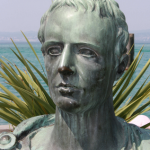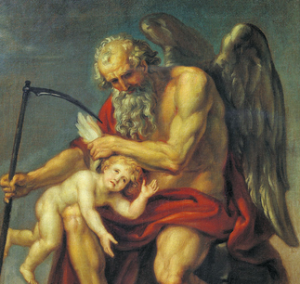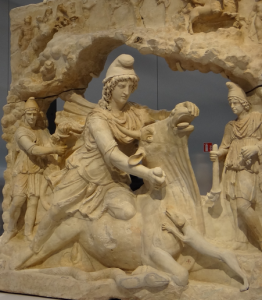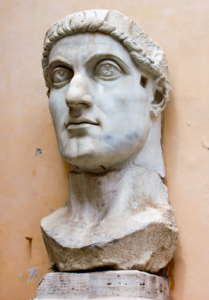Right around this time last year, I wrote a post about the history of significance of the Winter Solstice. As we draw closer to the Solstice and the Christmas holiday, I thought I would write a more detailed follow up post about how the way Christians celebrate the birth of Jesus has been influenced by ancient traditions.
When we think of Christmas, we think of spending time with friends and family, decorating the Christmas tree, and waiting for Santa Claus to visit. The cynical among us think of the holiday season as an excuse for companies to make a major advertising push to help the bottom line before the end of the fourth quarter. Regardless of your feelings about Christmas, let your inner historian at least appreciate the thousands of years of rich tradition have converged and adapted to produce this unique holiday.
Before Christianity
Walk through New York City’s Herald Square and spend a minute watching the shoppers frantically enter and exit Macy’s department store decked out in holiday regalia. Then try and wrap your mind around the fact that some of the seeds of Christmas as we know it were sown long before the Virgin Mary was forced to find refuge in a stable in Bethlehem.
The seeming disconnect can be quite a trip, but let your mind travel back to a time before skyscrapers and automobiles, before Newton told us what goes up must come down, before knights in shining armor stormed castles, and even before three wise men started following the brightest star to Bethlehem.
The Saturnalia

The Roman poet Catullus described Saturnalia as “the best of days.”
We find ourselves in the height of the late Roman Republic. At this point in history, the Roman Republic is the most powerful military and cultural force on the planet. The Republic controls most of the Mediterranean rim and Julius Caesar will soon incorporate Gaul (modern day France) into the Empire in one of the most storied, but brutally violently conquests in the history of the empire.
It was against this backdrop, that the Roman poet Catullus, a contemporary of Caesar, wrote his famous words about the festival of Saturnalia: “Saturnalibus, optimo dierum!” or “The Saturnalia, the best of days!” By this time, the ancient festival of Saturnalia had been celebrated for hundreds of years. Many historians view Saturnalia as one of the oldest influences on our Christmas holiday but you don’t need to be an archaeologist to see the similarities.

Many historians believe that the Saturnalia, in honor of the Roman god Saturn, is a predecessor to our Christmas.
The timing of Saturnalia is one of the most apparent elements that the Roman holiday shares with Christmas. This was not an accident, but we’ll get to that in a moment. Saturnalia was celebrated from December 17th through December 23rd and was thrown in honor of Saturn, one of the chief gods in the Roman pantheon. Saturn was thought to influence the outcome of the harvest which is why the festival in his honor was so important. A key element of Saturnalia was the reversal of the usually rigidly stratified social order of Rome. Slaves became temporary masters in their homes and peasants were in control of the city. The History Channel has a good write up of how Saturnalia was celebrated. The reversal of the social order can be seen as a predecessor to our focus on those in need during the holiday season.
Like Christmas, and most Roman festivals, Saturnalia involved heavy feasting and liberal consumption of wine. Imagine the ancient version of a Christmas ham and a glass of eggnog. Instead of hearing, “Merry Christmas!” on your way to the grocery store, you might hear, “Io Saturnalia!”, the traditional salute of the holiday.
Mithras and Sol Invictus

The birth of the deity Mithras was celebrated on December 25th, before the Christian church had settled on a firm date for this birth of Christ.
Another influential ritual that fell around the time of Saturnalia and on the date we now celebrate Christmas, was the birth of Mithras. Worshipping Mithras was outside the traditional Roman pantheon of Gods and was popular amongst the military and the upper classes. The Cult of Mithras probably has origins in the Zoroastrian tradition, but once coopted by the Romans, Mithras transformed into a distinct god with uniquely Roman rituals. The Roman version of the Mithras myth tells that the infant sun god was born out of a rock on December 25th.
The official sun god of the later Roman Empire was known as Sol Invictus, or the Unconquerable Sun, and while historians are somewhat unclear on the exact relation to Mithras, the birth of Sol Invictus was also celebrated on December 25th.
December 25th
So back to the the proximity between Saturnalia, the birth of Mithras, and what eventually became Christmas on the Roman calendar. The three major festivals fell within a week of one another. Was this just a coincidence or do the gods just dig the end of December? The answer is complicated, but there are two major reasons for the gauntlet of major holidays before the new year.
The first is the Winter Solstice. Cultures from around the globe, many who had no cultural contact with one another, celebrate the Solstice as the beginning of the end of darkness and the welcoming of the sun. In fact, many of our more modern Christmas traditions are drawn from Nordic and German solstice celebrations.
The second reason involves a bit more politicking and early public relations by the leaders of the nascent religion of Christianity. While some Christian historians argue that the date of December 25th was chosen as the birth of Christ because it falls nine months after March 25th, a proposed date for the Immaculate Conception, there is almost definitely more to the story.
The earliest documentation of December 25th as the birth of Jesus comes from St. Irenaeus almost 130 years after the traditional year of Christ’s birth. Some historians believe Christ was actually born in the spring, and some Eastern Orthodox traditions celebrate the birth in early January. So why all the confusion?
Part of the reason for the disagreement on the actual date is that there isn’t much evidence that early Christians celebrated the birth of Jesus at all. Then, as now among the devout, the most important holiday in Christianity was Easter, the remembrance of the Passion and the subsequent resurrection of Jesus.
Early Christians had a rough go of it in the Roman Empire to say the least. They were widely persecuted by Roman leadership. From brutal and unstable emperors, like Nero to the most academic and thoughtful, like Marcus Aurelius. Being fed to lions in the Coliseum or executed for performing Christian wedding ceremonies (St. Valentine is a story for another day) were not uncommon ways of being punished for performing Christian rituals.

Constantine the Great’s conversion to Christianity shepherded in the Christianity as the Roman Empire’s official religion.
As the empire began to decay in the later centuries, the tide of Christianity began to turn. More and more Romans, especially the poor and enslaved, turned to Christianity as a source of hope. The groundswell culminated in the deathbed conversion of Emperor Constantine the Great. Constantine credited his conversion to a Christian vision he had before a battle which he felt led to a seminal victory. After Constantine’s conversion, it was only a matter of time before the official religion of the Roman Empire became Christianity.
So back to December 25th. An edict declaring Christianity the official religion is one thing. Having an empire of millions with thousands of years of pagan tradition buy in is another. Many historians believe that in the 4th century A.D., leaders of the Christian church decided to celebrate Christ’s birth during the same period as Saturnalia and the birth of Mithras as a way of softening the blow to pagan religions.
Ironically, the Christian church deftly applied the Roman tactic of conquest by inclusion into their strategy of religious conversion. Unsurprisingly, the disappearance of the Cult of Mithras, which had been made an official religion of the military by Emperor Aurelian in 274, corresponds with the introduction of Christmas in the 4th century.
The Feast of the Nativity, as it was known, spread to Egypt by the early 400s and was widely celebrated in England and Scandinavia by the 7th century A.D.
Shadows of Saturnalia
One of the pervasive traditions of Saturnalia that survived into the Middle Ages was the idea of reversal of the social order during the Christmas season.
An officer known as The Lord of Misrule was appointed from amongst the peasants to preside over the Feast of Fools, the Christmas feast which carried on the traditions of excessive drinking and partying which accompanied Roman Saturnalia. Drunken peasants were known to visit the homes of the wealthy and ask (or demand) gifts, food, and drink.
Originally an homage to the Roman tradition of reversal of the social strata, the mobs would sometimes become violent, causing the church and the wealthy to make a concerted effort to rebrand Christmas as a peaceful holiday to be celebrated in the home with family.
We just hurtled through about a thousand years of Christmas tradition. I hope it shed some light on where some of our customs came from.
Notes and More Information
Check out the History Channel’s History of Christmas, the and the Wikipedia pages for Saturnalia, Sol Invictus, The Cult of Mithras, and the Lord of Misrule to learn more.
If you want to learn more about Christmas in America, check out this piece on when the Puritans banned Christmas in Boston.
